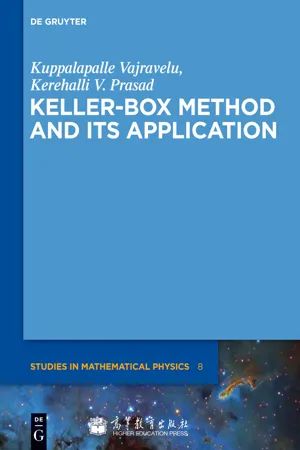
eBook - ePub
Keller-Box Method and Its Application
This is a test
- 412 pages
- English
- ePUB (mobile friendly)
- Available on iOS & Android
eBook - ePub
Keller-Box Method and Its Application
Book details
Book preview
Table of contents
Citations
About This Book
Most of the problems arising in science and engineering are nonlinear. They are inherently difficult to solve. Traditional analytical approximations are valid only for weakly nonlinear problems, and often break down for problems with strong nonlinearity. This book presents the current theoretical developments and applications of the Keller-box method to nonlinear problems. The first half of the book addresses basic concepts to understand the theoretical framework for the method. In the second half of the book, the authors give a number of examples of coupled nonlinear problems that have been solved by means of the Keller-box method. The particular area of focus is on fluid flow problems governed by nonlinear equation.
Frequently asked questions
At the moment all of our mobile-responsive ePub books are available to download via the app. Most of our PDFs are also available to download and we're working on making the final remaining ones downloadable now. Learn more here.
Both plans give you full access to the library and all of Perlego’s features. The only differences are the price and subscription period: With the annual plan you’ll save around 30% compared to 12 months on the monthly plan.
We are an online textbook subscription service, where you can get access to an entire online library for less than the price of a single book per month. With over 1 million books across 1000+ topics, we’ve got you covered! Learn more here.
Look out for the read-aloud symbol on your next book to see if you can listen to it. The read-aloud tool reads text aloud for you, highlighting the text as it is being read. You can pause it, speed it up and slow it down. Learn more here.
Yes, you can access Keller-Box Method and Its Application by Kuppalapalle Vajravelu, Kerehalli V. Prasad, Higher Education Press in PDF and/or ePUB format, as well as other popular books in Physical Sciences & Mathematical & Computational Physics. We have over one million books available in our catalogue for you to explore.
Information
Chapter 1
Basics of the Finite Difference Approximations
In this chapter we introduce the essentials of finite difference approximations for solving linear/nonlinear differential equations. In Section 1.2, we study the time-dependent differential equations beginning with the initial value problem and then present some theoretical issues pertaining to the equations. Oftentimes when dealing with nonlinear differential equations, the questions of the existence and uniqueness of a solution are of importance, and inveterate. Section 1.3, deals with the discretization of the differential equations and the solution processes for the coupled boundary value problems (BVPs). Further, it also explains the differences between the single-step and multi-step methods of solving BVPs. In Section 1.4, we extend the ideas of the prior section to obtain the numerical solutions for partial differential equations (PDEs). Finally, in Section 1.5 we present the numerical solutions to the PDEs, viz., elliptic, parabolic and hyperbolic differential equations.
1.1 Finite difference approximations
Our goal is to find approximate solutions to differential equations, i.e., to find a function (or some discrete approximation to this function) which satisfies a given relationship between its derivatives on some given region of space and/or time, along with some boundary conditions at the edges of the domain. In general this is a difficult problem and only rarely can an analytic formula be found for the solution. A finite difference method proceeds by replacing the derivatives in the differential equations by finite difference approximations. This gives a large algebraic system of equations to be solved in place of the differential equation, something that is easily solvable on a computer. Before tackling this problem, we first consider the more basic question of how we can approximate the derivatives of a known function by finite difference formulas based only on values of the function itself at discrete points.
Besides providing a basis for the later development of finite difference methods for solving differential equations, this allows us to investigate several key concepts such as the order of accuracy of an approximation in the simplest possible setting.
Let u(x) represent a function of one variable that, unless otherwise stated, will always be assumed to be smooth, meaning that we can differentiate the function several times and each derivative is a well-defined bounded fu...
Table of contents
- Title Page
- Copyright Page
- Preface
- Table of Contents
- Chapter 0 - Introduction
- Chapter 1 - Basics of the Finite Difference Approximations
- Chapter 2 - Principles of the Implicit Keller-box Method
- Chapter 3 - Stability and Convergence of the Implicit Keller-box Method
- Chapter 4 - Application of the Keller-box Method to Boundary Layer Problems
- Chapter 5 - Application of the Keller-box Method to Fluid Flow and Heat Transfer Problems
- Chapter 6 - Application of the Keller-box Method to More Advanced Problems
- Subject Index
- Author Index